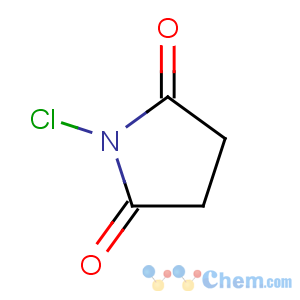Title: N-Chlorosuccinimide
CAS Registry Number: 128-09-6
CAS Name: 1-Chloro-2,5-pyrrolidinedione
Synonyms: succinchlorimide
Molecular Formula: C4H4ClNO2
Molecular Weight: 133.53
Percent Composition: C 35.98%, H 3.02%, Cl 26.55%, N 10.49%, O 23.96%
Literature References: Prepn from succinimide: Hirst, Macbeth,
J. Chem. Soc. 121, 2169 (1922); Zimmer, Audrieth,
J. Am. Chem. Soc. 76, 3856 (1954). Crystal structure: Brown,
Acta Crystallogr. 9, 193 (1956);
14, 711 (1961). Toxicity data: Stohlman, Smith,
Public Health Rep. 59, 541 (1944).
Properties: Orthorhombic crystals, mp 150-151°. Odor of chlorine. Acid to litmus (1:50 aq soln). One gram dissolves in about 70 ml water, 150 ml alcohol, 50 ml benzene. Sparingly sol in ether, chloroform, carbon tetrachloride. Liberates iodine from potassium iodide solns, and bromine from sodium bromide solns. MLD orally in rats: 2.7 g/kg (Stohlman, Smith).
Melting point: mp 150-151°
Toxicity data: MLD orally in rats: 2.7 g/kg (Stohlman, Smith)
Use: Chlorinating agent.

